Antimalarial Drugs Classification
Classification of antimalarial drugs on the basis of mode of action and chemical structure.
PHARMACOLOGY
Alok BAINS
5/14/20232 min read


Classification of Antimalarial Drugs
Com[iled by Alok Bains
Antimalarial drugs can be classified on the basis of their mode of action and chemical structure.
Classification on the basis of Mode of Action.
Antimalarial drugs are classified based on their action in the various stages of the plasmodium life cycle.
Tissue schizonticides: They act on plasmodium schizonts inside liver cells before the start of the erythrocytic stage of Plasmodium. They prevent further growth of Plasmodium and the appearance of malaria symptoms. Eg. Pyrimethamine and Primaquine. But it is not possible to detect malaria infection at this stage. Thus it is A theoretical classification not practical. They can be used as prophylactic agents to prevent malaria.
Blood schizonticides: They act on schizonts entered into blood plasma from liver cells. They kill schizonts in blood plasma. They terminate clinical attacks of malaria and symptoms of malaria. These are the most commonly used antimalarial drugs. Eg. chloroquine, quinine, mefloquine, halofantrine, pyrimethamine, sulfadoxine, sulfones, tetracyclines etc.
Gametocytocides: They act on sexual forms of the parasite in the blood to kill them. They mainly prevent transmission of the malarial infection to the mosquitoes from humans. Chloroquine and quinine act as gametocytocide against P. vivax and P. malariae, but not against P. falciparum. Primaquine acts as gametocytyce against all plasmodia.
Sporontocides: They block the development of Oocysts in the mosquito and block the transmission of malarial infection from mosquitoes to humans. Eg. Primaquine and chloroguanide,
Artemisinin compounds (artemisinin, dihydroartemisinin, artemether, artesunate)
Chemotherapy of malaria includes a blood schizonticide, a gametocytocide and a tissue schizonticide (in the case of P. vivax and P. ovale). A combination of chloroquine and primaquine is effective in all types of malaria.
World Health Organisation recommend Artemisinin-based combination therapies (ACTs) to treat Plasmodium falciparum malaria. ACTs combine 2 active pharmaceuticals with different mechanisms of action, including derivates of artemisinin extracted from the plant Artemisia annua and a suitable antimaterial drug. Artemisinin reduces the number of parasites during the first 3 days of treatment and the partner drug eliminates the remaining Plasmodia. WHO recommends does not recommend Artemisinin as a prophylactic agent to prevent malaria. Artemisinin is especially useful in drug resistance to malaria
Antimalarial drugs can be classified into the following three groups according to their chemical structure and mode of action.
Aryl aminoalcohol compounds: quinine, quinidine, chloroquine, amodiaquine, mefloquine, halofantrine, lumefantrine, piperaquine, tafenoquine.
Antifolate compounds: pyrimethamine, proguanil, chlorproguanil, trimethoprim.
Artemisinin compounds: (artemisinin, dihydroartemisinin, artemether, artesunate)
Several antibacterial agents also act as antimalarial agents. But their action against malarial parasites is very slow. Thus they are not recommended alone. They are recommended in combination with antimalarial drugs. All antimalarial drugs active against Plasmodium falciparum are also effective against other forms of plasmodium except are active against all types of plasmodium except antifolates. Antifols are less effective against Plasmodium vivax.
Atovaquone is an antimalarial in its own class and belongs to Naphthoquinones. It has a unique mode of action; combined with proguanil in the treatment of malaria..
Classification based on the chemical structure:
Aryl amino alcohols: Quinine, Quinidine (cinchona alkaloids), Mefloquine, Halofantrine.
4-aminoquinolines: Chloroquine, Amodiaquine.
Folate synthesis inhibitors:
Type 1 – competitive inhibitors of dihydropteroate synthase – Sulphones, Sulphonamides.
Type 2 – inhibit dihydrofolate reductase – Biguanides like Proguanil and Chloroproguanil; Diaminopyrimidine like Pyrimethamine
8-aminoquinolines: Primaquine, WR238, 605
Antimicrobials: Tetracycline, Doxycycline, Clindamycin, Azithromycin, Fluoroquinolones.
Peroxides: Artemisinin (Qinghaosu) derivatives and analogues – artemether, arteether, artesunate, artelinic acid
Naphthoquinones: Atovaquone.
Iron chelating agents: Desferrioxamine
